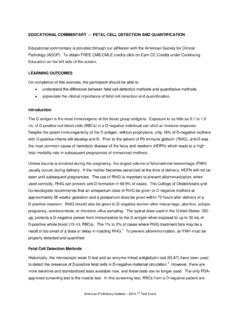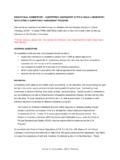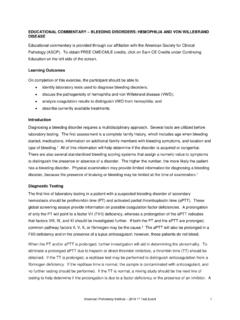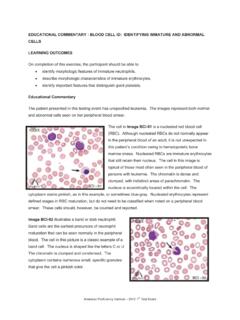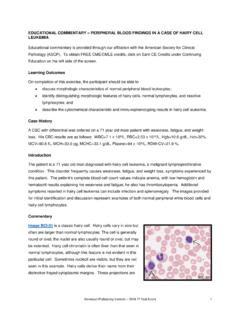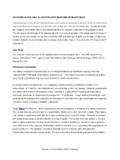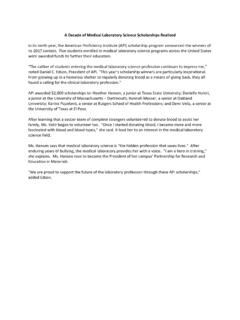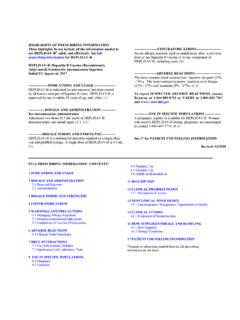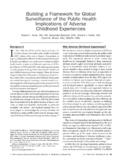Transcription of ASSAYS FOR ANTINUCLEAR ANTIBODIES - api-pt.com
1 EDUCATIONAL COMMENTARY ASSAYS FOR ANTINUCLEAR ANTIBODIES Educational commentary is provided through our affiliation with the American Society for Clinical Pathology (ASCP). To obtain FREE CME/CMLE credits, click on Earn CE Credits under Continuing Education on the left side of the screen. Learning Outcomes On completion of this exercise, the participant should be able to discuss autoimmunity; describe the nonspecific symptoms of autoimmune diseases; discuss the various laboratory ASSAYS and their uses in the diagnosis of autoimmune diseases; and compare ANTINUCLEAR antibody ASSAYS . Introduction The role of the immune system is to defend the body against pathologic organisms such as viruses, bacteria, fungi, and parasites. In some cases, the immune system becomes dysregulated and directs itself against its own cells or organs.
2 This condition is known as autoimmunity, and the diseases that result are designated as autoimmune diseases. When the immune system fails to recognize the body s own cells or tissues as self and mounts the same type of response that is directed against foreign antigens, the protective immunologic tolerance developed in the fetal and neonatal stages of life is compromised. A wide spectrum of autoimmune syndromes ranging from organ-specific to systemic may develop, affecting virtually any organ of the body. autoimmune diseases are difficult to diagnose, because the symptoms are usually nonspecific with subtle onset, intermittent, highly variable from patient to patient, and often similar to those of other diseases. Symptoms may include fatigue, joint pain, swelling, abdominal pain, fever, and swollen glands. Further diagnostic confusion is created when more than one organ is affected.
3 Often, a patient s symptoms are considered psychosomatic or stress related. According to the American autoimmune Related Diseases Association, it takes an average of years and five physicians before an accurate diagnosis is determined. The many medical specialties involved in treatment, including rheumatologists, gastroenterologists, nephrologists, endocrinologists, neurologists, and hematologists, contribute to the difficulty in treating autoimmune diseases. Because not all symptoms of autoimmune diseases are treated by the same physician, similarities are often overlooked and treatment modalities are not The immune response is a finely balanced system. Too little activity results in disease, too much activity results in autoimmunity. Although the mechanisms are known, the cause of autoimmunity is unknown. Studies indicate that genetic and environmental factors are involved in the development of autoimmune diseases.
4 These diseases are found to cluster in families, and often individuals diagnosed with one American Proficiency Institute 2018 1st Test Event 1 EDUCATIONAL COMMENTARY ASSAYS FOR ANTINUCLEAR ANTIBODIES (cont.) syndrome develop another. Triggers of the autoimmune process include bacterial and viral infections, certain drugs, chemical and environmental irritants, and chronic inflammation related to food sensitivities. It is possible that a preceding infectious organism or substance damages cells, exposing those cells to the immune system. Inflammation plays a critical role in all autoimmune diseases. Stimulation of the immune system activates the inflammatory process. Inflammation is responsible for many of the symptoms of autoimmune diseases, which include redness, swelling, heat, and sometimes loss of function. There are more than 100 autoimmune diseases, which can be chronic, incapacitating, and, often, life-threatening.
5 autoimmune disease is among the top 10 causes of death in women younger than 65 In most cases, the patient experiences symptoms that fluctuate between flareups and remission. Currently, there are no cures for autoimmune diseases. autoimmune disease affects 50 million people in the United States, about 15% of the population, with about 75% of these cases occurring in Laboratory Testing Systemic autoimmune rheumatic diseases are a subset of autoimmune diseases that primarily affect the joints and muscles. These include rheumatoid arthritis, systemic lupus erythematosus, Sj gren syndrome, scleroderma, polymyositis, and dermatomyositis. The most common screening test for systemic autoimmune rheumatic diseases is the ANTINUCLEAR antibody (ANA) assay. These ASSAYS detect ANTIBODIES in the patient s serum directed against components of the cell nucleus.
6 ANTINUCLEAR antibody testing may be performed using indirect immunofluorescence assay (IFA), enzyme immunoassay (EIA), or multiplex immunoassay. Immunofluorescence Assay / Indirect Immunofluorescence Assay The American College of Rheumatology issued a position statement in 2009 choosing the IFA, also known as the indirect immunofluorescence assay, as the criterion standard assay for ANAs produced in autoimmune The IFA is a screening test able to detect more than 100 autoantibodies directed against various nuclear and cytoplasmic antigens. ANTINUCLEAR antibody results report the antibody titer along with one of six patterns used by most laboratories. The patterns include homogeneous, peripheral (rim), speckled, nucleolar, centromere, and proliferating cell nuclear The IFA is a labor-intensive procedure requiring considerable expertise to properly interpret results.
7 The procedure involves layering the patient sample on a commercial slide coated with a substrate of human epithelial (HEp-2) cells. If the patient serum contains ANAs, the ANAs will bind to the nuclei of the cells on the slide. The slide is then washed to remove all ANTIBODIES that have not combined with the substrate, and a conjugate composed of an antihuman antibody tagged with a fluorescent dye is added. A sandwich of HEp-2 cells, patient antibody if present, and conjugate is formed. Another washing removes all ANTIBODIES not incorporated American Proficiency Institute 2018 1st Test Event 2 EDUCATIONAL COMMENTARY ASSAYS FOR ANTINUCLEAR ANTIBODIES (cont.) into the sandwich. The slide is then examined with a fluorescent microscope. Typically, patient specimens are screened using a 1:40 dilution. If the screen is positive, additional dilutions are performed and tested.
8 The pattern and titer produced in positive samples is reported. Homogeneous and peripheral patterns are usually associated with systemic lupus erythematosus. Speckled patterns correspond with scleroderma, rheumatoid arthritis, and mixed connective tissue diseases. The nucleolar pattern may indicate scleroderma or Sj gren syndrome. In 2002, to address the problems incurred in the interpretation of ANAs, automation was introduced to ANA IFA. Digital image analysis and recognition algorithms are now used to discriminate between negative and positive test results and to determine the pattern produced. Light intensity correlates with titer. Digital images can be viewed by the technologist and verified or revised. Problems with the automated system occur when the patient sample has mixed patterns or presents with one of the less common Enzyme-Linked Immunosorbent Assay / Enzyme Immunoassay Enzyme-linked immunosorbent assay (ELISA) is a solid-phase immunologic assay.
9 Monoclonal ANTIBODIES coated on microtiter plates act as antigens and are used to measure ANTIBODIES , other proteins, hormones, and peptides in patient specimens. This procedure is also known as enzyme immunoassay. A monoclonal antibody is adsorbed on a solid-phase microtiter plate. The patient serum is then added and incubated. If the serum contains the antibody sought (in this case, ANA), the antibody will attach to the antigen on the solid-phase. The microtiter plate is washed to remove any ANTIBODIES in the patient serum that are not bound to the antigen-antibody complex attached to the solid phase. A conjugate is added, composed of a secondary antibody with an enzyme tag that will attach to the patient antibody in a different location. The primary enzymes used as tags in this procedure are alkaline phosphatase and horseradish peroxidase.
10 This step is followed by an incubation period. The plate is washed again to remove any excess conjugate that has not attached to the patient antibody. A substrate for the enzyme tag is added, and a color is produced. After a specified period of time, a stop solution is added. The resultant color is read on a spectrophotometer. The more color produced, the higher the concentration of antibody present in the patient serum. Improper washing, failure to incubate properly, and poor pipetting may result in aberrant results. Multiplex Immunoassay Multiplex immunoassay is another solid-phase immunoassay. Multiplex immunoassay for ANAs involves microspheres (usually 8- m beads) coated with clinically significant nuclear antigens. The number of antigens involved varies by manufacturer but usually involves 11 to 13 beads. The beads, when detected by a laser, will produce a specific color and can be identified.

